Pineapple Upside Down Cheesecake Recipe
Bringing back the retro classic! You'll love this Pineapple Upside Down Cake with the sticky caramelised edges on the pineapple. The ultra-moist, tender vanilla cake is studded with pineapple pieces and infused with pineapple juice. You can't help but smile at the sight of this cheerful-looking cake. Right? 🙂
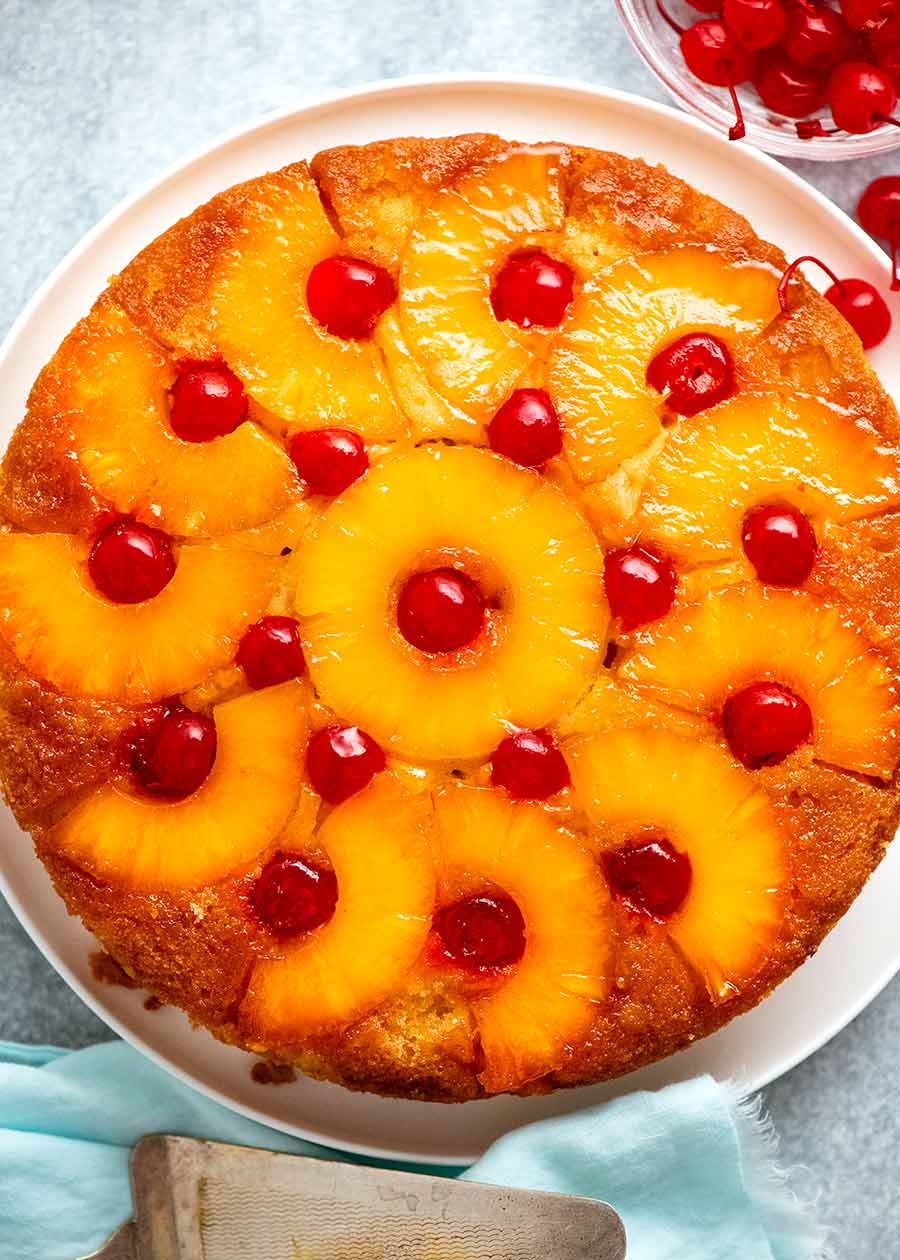
Pineapple Upside Down Cake
"Everything is brown!", I observed, looking at the latest dessert recipes I've shared. "Chocolate, caramel, fruit cake – brown, brown, brown. Give me some COLOUR!"
And therein lies the exact reason I chose to share this cake today. A girl needs a splash of colour in her life every now and then, despite her commitment to all things chocolate.
And this girl needs little encouragement to bring retro fun into her life! Disco balls and flares, perms and … Apricot Chicken?? Hmm, I might pass on the Apricot Chicken!
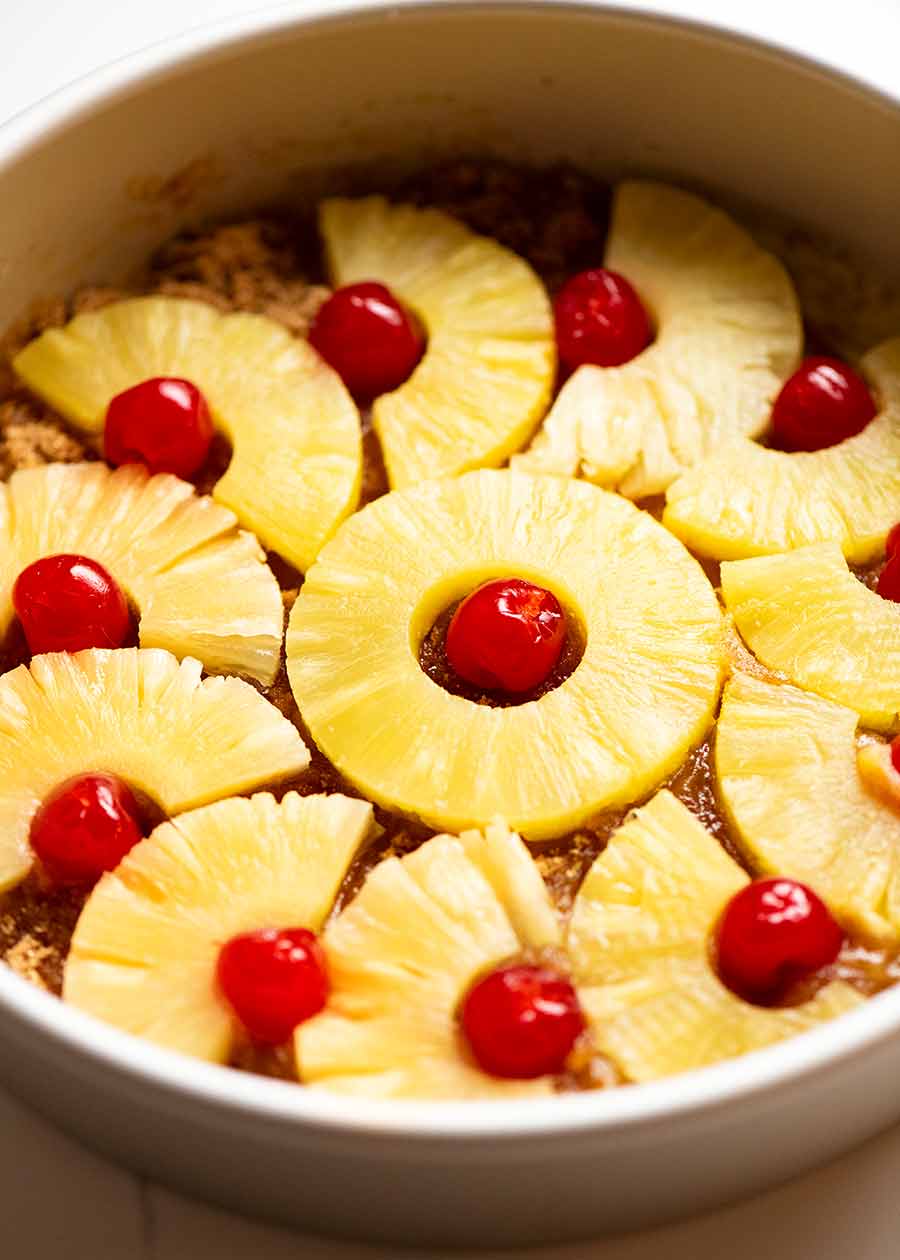
Pineapple Upside Down Cake – What it tastes like
Pineapple Upside Down Cakes were all the rage from the 60's right through the 80's. Though as far as Aussies are concerned, they never went out of fashion. Rarely a summer would go by without one making an appearance at a barbie at some stage! (That's a barbecue to you non-Aussies!)
"Upside Down" refers to the way the cake is made. Like a French tarte tatin, the cake is assembled and baked with fruit at the bottom and the batter on top. To turn it out, you flip the cake upside down, leaving you with the glistening, caramel-napped fruit layer exposed and the cake underneath it – Upside Down Cake!
The cake part is a vanilla cake. You'll see versions that are more on the pudding-like side (ie. quite dense and wet like syrup-soaked cakes) and others that are quite dry sponge cakes. Mine lies squarely in the middle. It's soft and fluffy, like my classic Vanilla Cake (except this is faster to make), but it is a bit more moist than traditional cakes because of the juices from the pineapple (and we are all for those juices!).
As for that pineapple topping? Think juicy pineapple pieces with caramelised edges, studded with sweet candied cherries. It is literally the crowning glory of this cake!
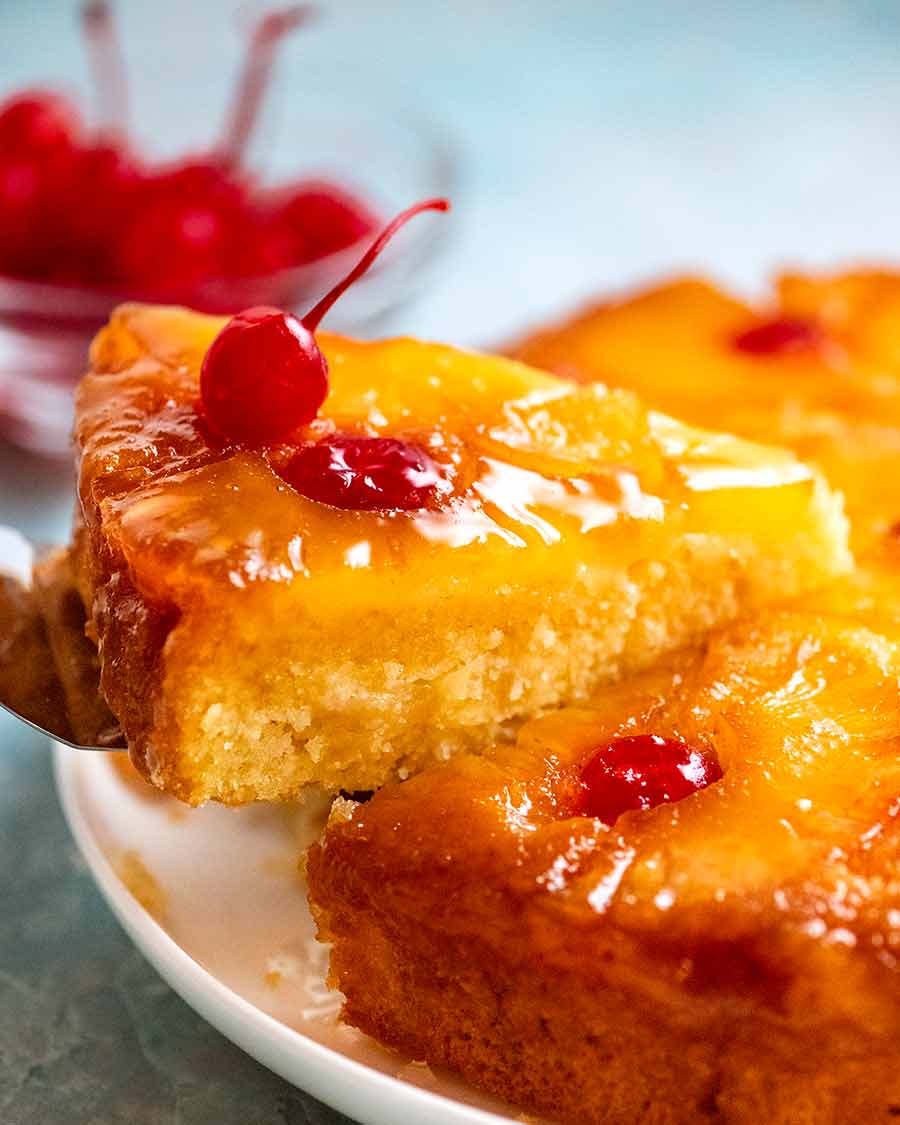
What you need for Pineapple Upside Down Cake
Pineapple Cherry Topping
Here's what you need for the signature pineapple-and-cherry-studded topping:
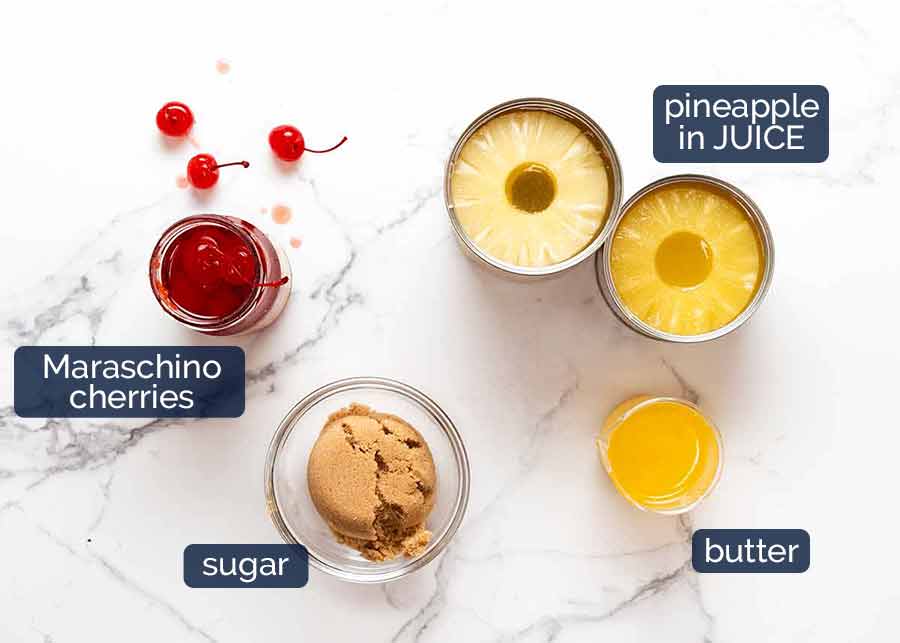
-
Pineapple slices in JUICE – Be sure to get canned pineapple slices in juice rather than syrup. Syrup is too sweet for our needs. Also, we use some of the juice for the batter – and we save the rest for cocktails!
The recipe calls for 600g/20oz of canned pineapple. Those of you in Australia will need 1 large can (425g) and 1 small can (225g) which together totals 650g. This is more pineapple than you need to cover the surface. So chop up leftovers and toss them into the batter!
-
Maraschino cherries (image below) – These are preserved, sweetened cherries commonly used as a cocktail garnish, such as for a Tequila Sunrise, and desserts like Black Forest Cake. True maraschino cherries are marinated in a cherry liqueur called maraschino – hence the name. However these are expensive and hard to source, so mostly you'll find cheaper substitutes that don't use real maraschino. These are totally fine and actually better here for their vivid colour! Find it at liquor stores and some grocery stores, such as Harris Farms in Sydney. Substitute with glac é cherries; and
-
Butter and brown sugar – Together, these form the shiny caramel coating on the top of the cake.
-
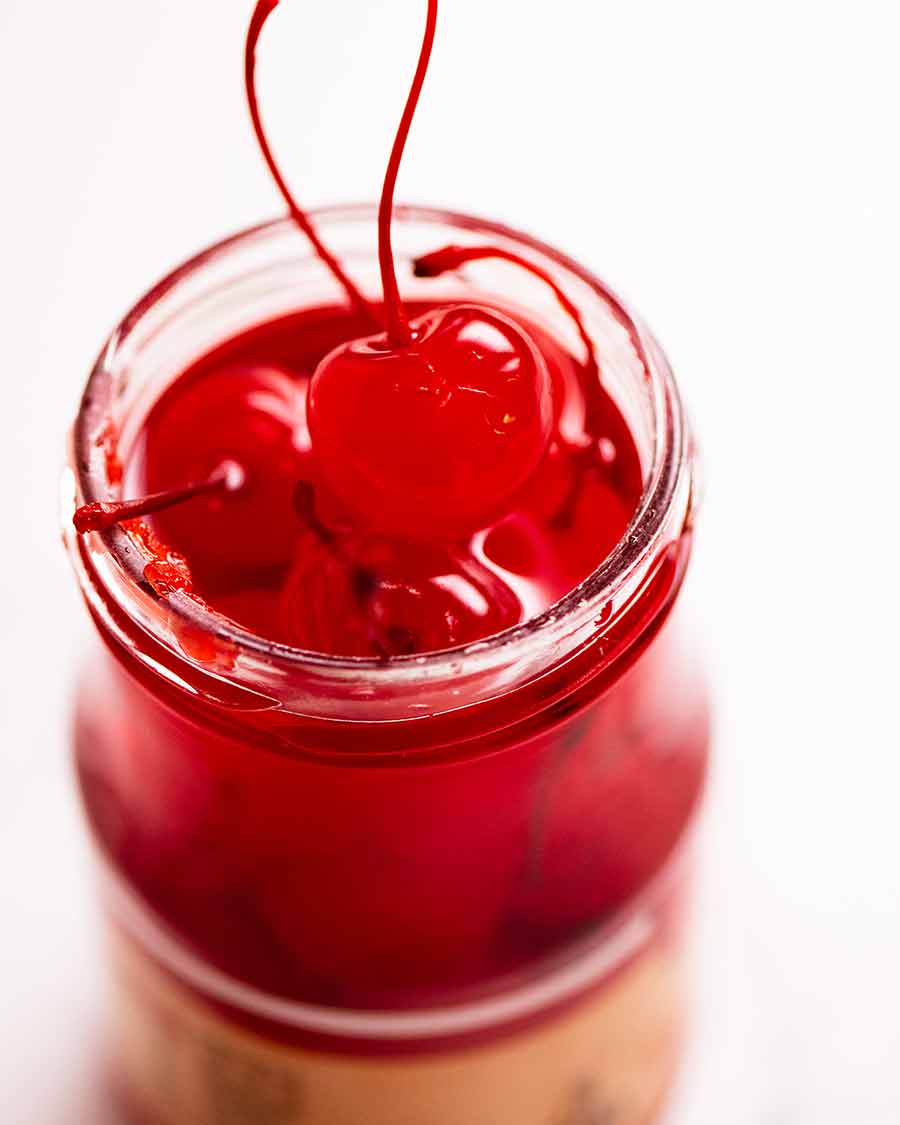
Maraschino cherry -
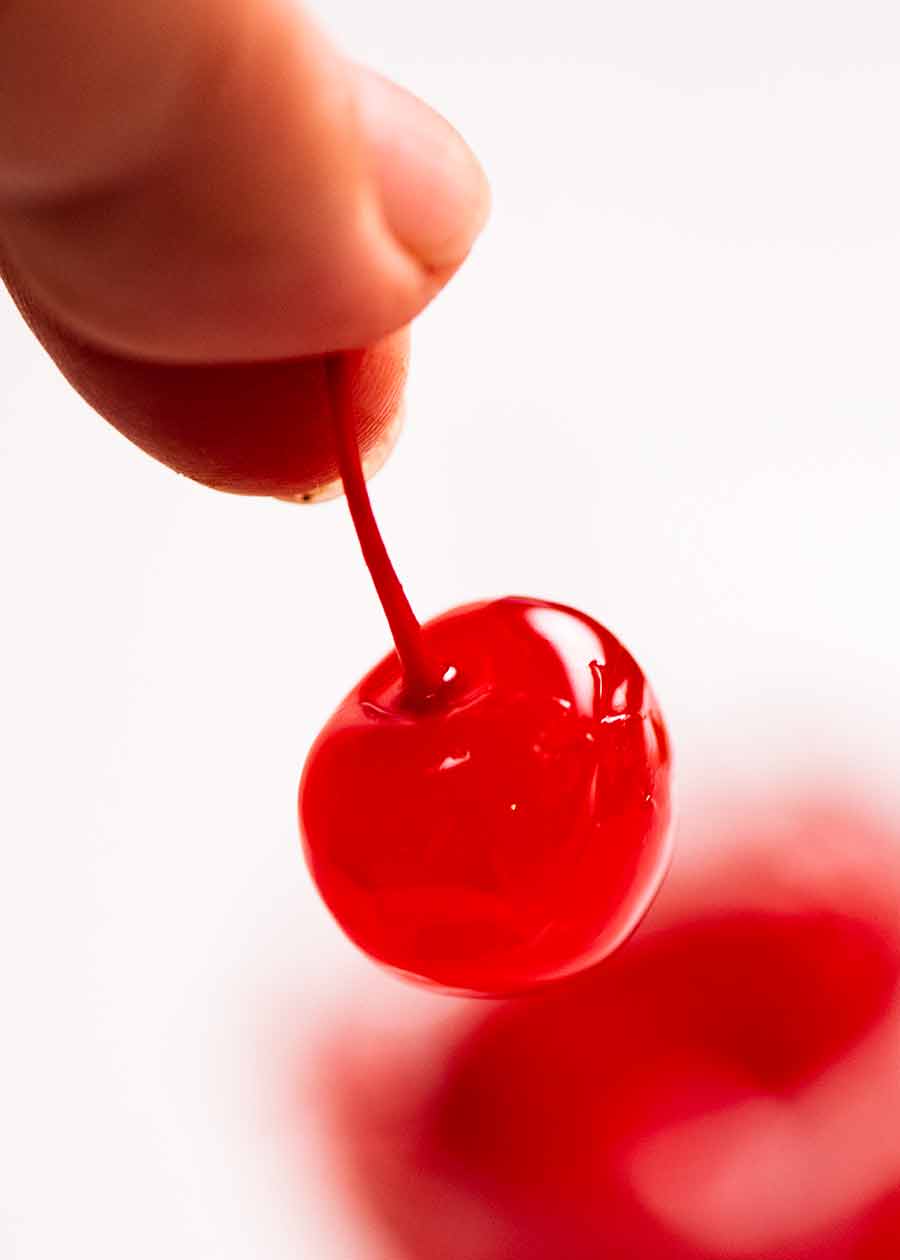
Cake Batter
Here's what you need for the cake batter:
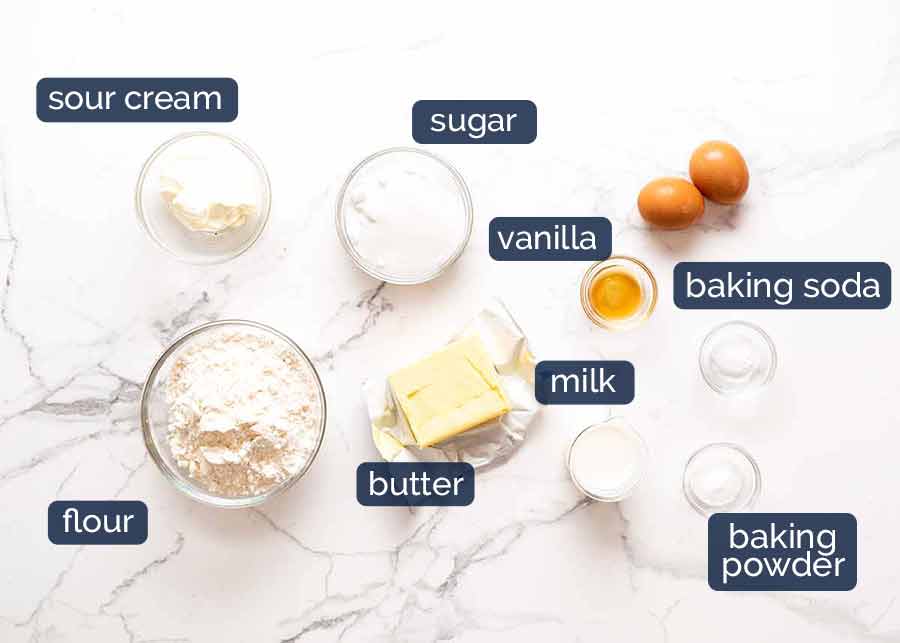
-
Flour – Just plain/all-purpose flour;
-
Sour cream – This is a neat baker's trick to thicken the batter without adding more flour, keeping the crumb of the cake nice and moist. We need a thick batter for this cake so it doesn't leak under the pineapple slices which would tarnish the look of the surface!
-
Sugar – White sugar, which makes a nice light coloured cake crumb;
-
Unsalted butter – Softened to room temperature (18°C/64°F). This is the temperature at which butter is pliable and can be beaten (creamed) so it's nice and fluffy, which in turn means a fluffy cake.
If the butter is so soft that when you touch it, you end up with a thick slick of grease on your fingers, it is too soft. This will likely lead to a greasy cake, or one that does not rise as much as it should. If your butter is >20°C/68°F, I wouldn't use it for a cake. Refrigerate to chill before using;
-
Large eggs, at room temperature – "Large eggs" are 55-60g / 2oz each, which an industry standard. Large eggs are sold in cartoons labelled as such.
It's important to ensure the eggs are at room temperature before using in cakes to ensure they incorporate fully. Fridge-cold eggs added into a batter with butter in it can cause the butter to solidify – spelling disaster!
What is an egg at room temperature? Just take it out 30 minutes prior to using. As long as the egg is not fridge-cold when you hold it, it's fine. There is more margin for error with eggs than there is with butter;
-
Baking soda AND baking powder – I always try to avoid the need for using both but sometimes it's inevitable! Baking soda is like baking powder on steroids, it is 3x stronger. When combined with an ingredient with even a bit of acid in it (sour cream in this case), you get a great lift boost when the cake goes in the oven. This cake benefits from that extra boost because the batter is quite heavy. So unfortunately, we need both!
-
Milk – Any fat % is fine here, it's not a major ingredient; and
-
Vanilla extract – This adds better flavour than vanilla essence, but essence is fine to use too.
How to make Pineapple Upside Down Cake
I feel like there's a lot of process step photos below, which is quite misleading given how straightforward the recipe is. It's not hard, I promise. 🙂
Part 1: Prepare pineapple topping
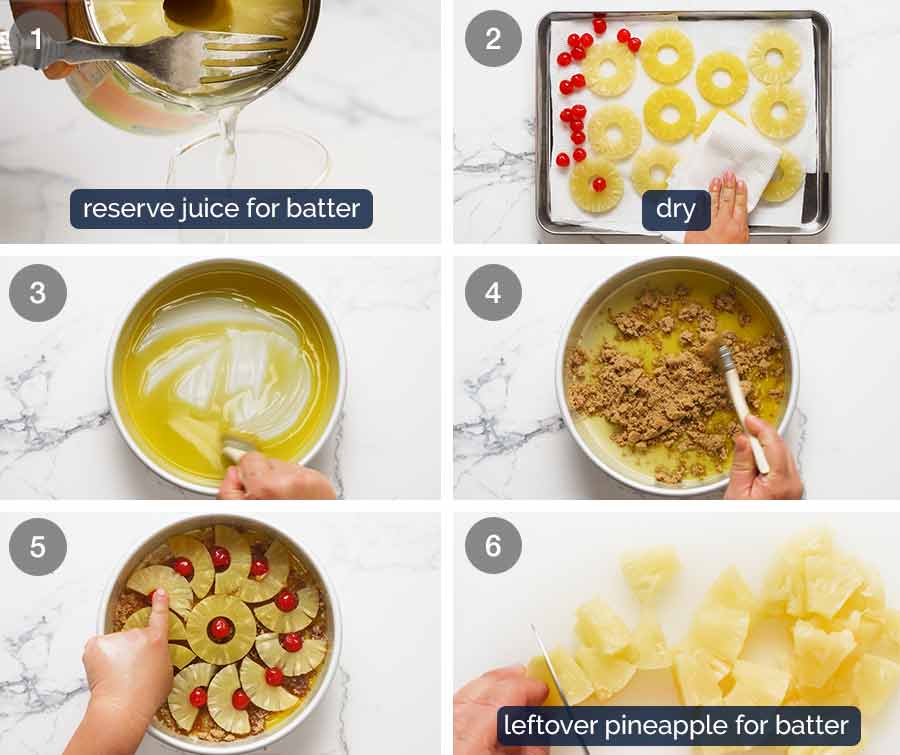
-
Pineapple juice for batter – Measure out 1/4 cup pineapple juice and set aside for the batter. Reserve the remaining juice for smoothies or cocktails!
-
Pat fruit dry – Pat the pineapple slices and cherries dry;
-
Melted butter – Pour melted butter in the cake pan and brush it over the bottom and sides;
-
Sugar – Sprinkle the brown sugar around the base. No need to be too even here, the caramel will just move around once melted;
-
Arrange pineapple slices – Cover base with pineapple slices. You can arrange as depicted, using one whole ring surrounded by halves (giving most coverage), or you can just use whole rings. Decorate with cherries, either just in the pineapple ring holes (as depicted), or with extra ones filling gaps between the pineapple. Press pineapple and cherries down firmly. This reduces the amount of caramel that adheres to the final presentation surface when baking so you get better vibrant yellow and red colour pops (that are not tarnished by caramel); and
-
Chop leftover pineapple – We're going toss these into the batter. Note: you may not have leftover pineapple, it depends on the size of your can(s)!
Part 2: The batter
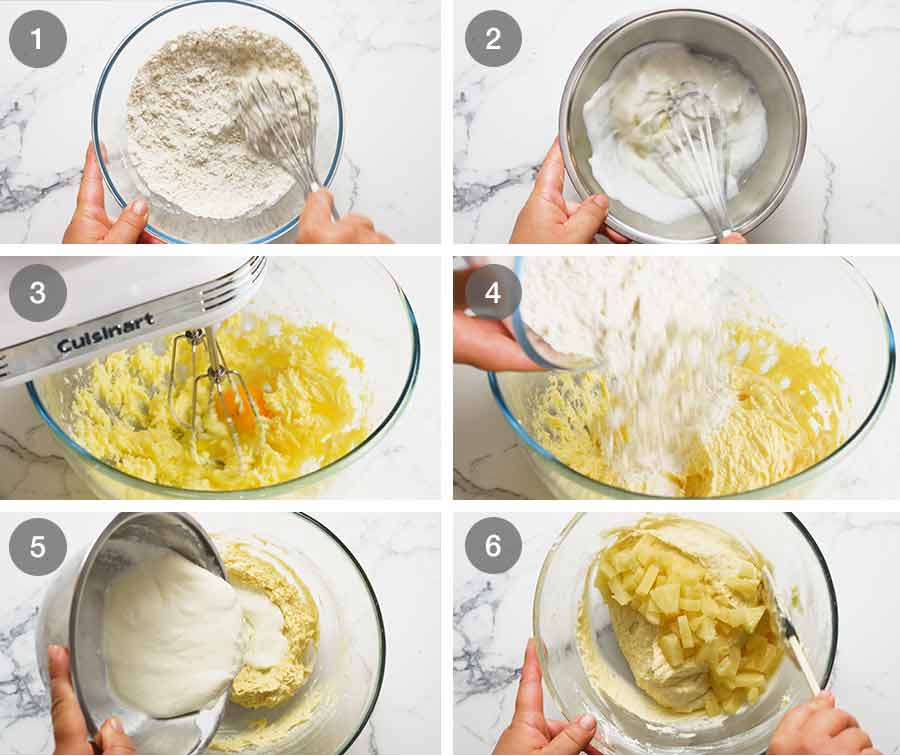
-
Dry ingredients – Whisk them in a bowl;
-
Wet ingredients – Whisk the milk, sour cream and pineapple juice in a separate bowl;
-
Cream butter and sugar – Then in a third (and I promise, last!) bowl, beat the softened butter and sugar for 2 minutes until it's light and fluffy;
-
Add flour in 3 parts – Use a rubber spatula to fold the flour through rather than an electric mixer. This will ensure you don't over-mix the batter which leads to a tough cake crumb;
-
Alternate with Milk Mixture (Wet ingredients mix) – Between each addition of the Flour Mixture, add the Milk Mixture in 2 parts. So: 1/3 flour, mix, 1/2 milk, mix, 1/3 flour, mix, 1/2 milk, mix, 1/3 flour mix. This might seem tedious to you at the time, but just wait until you see how soft the cake comes out!
-
Stir through pineapple pieces – Do this right at the end. Stir just to disperse the pineapple through.
Part 3: Baking
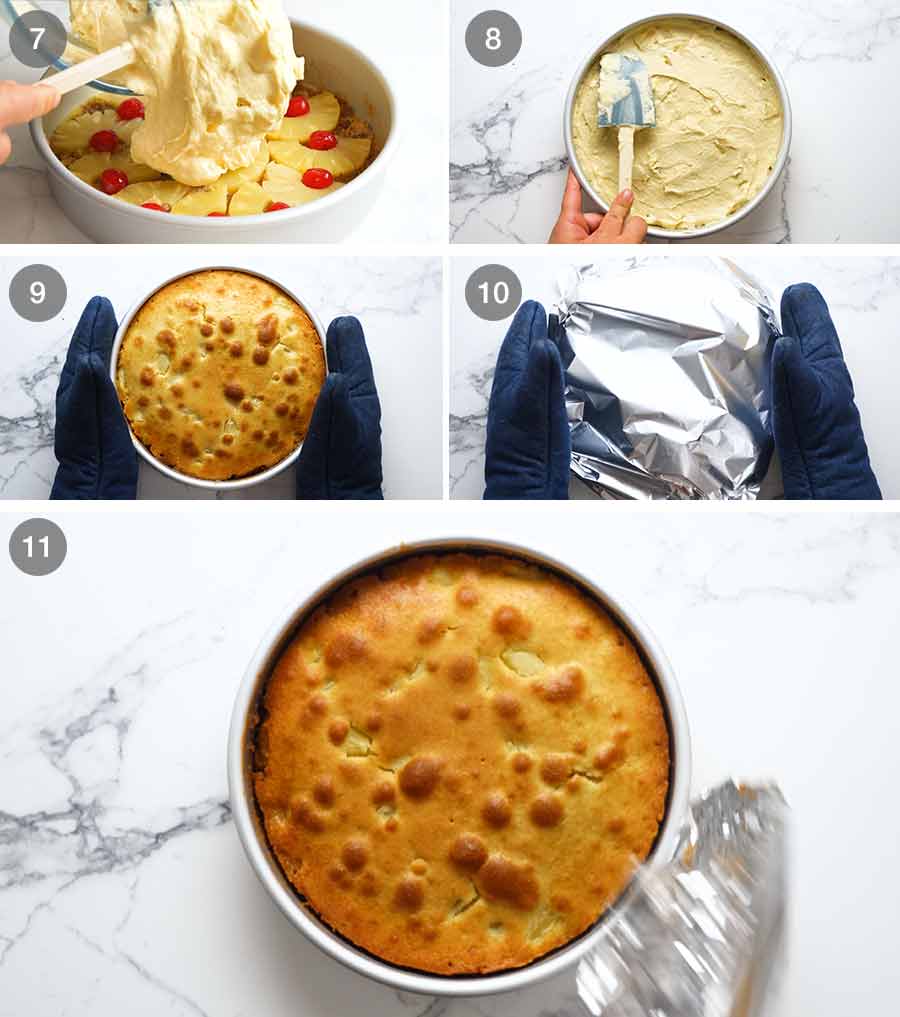
-
Scrape batter into cake pan over the pineapple;
-
Spread to level surface;
-
Bake uncovered for 30 minutes at 180°C/350°F (160°C fan);
-
Cover with foil, then bake for a further 15 minutes;
-
Check cake is cooked – Remove foil and check to ensure the cake is cooked by inserting a toothpick into the centre. It should come out with just crumbs on it, no raw batter!
Part 4: How to turn out Pineapple Upside Down Cake
There is nothing to fear with this step! And most importantly, I have NEVER had problems with the pineapple sticking to the cake pan – and as you can see, I do not use a non-stick pan!
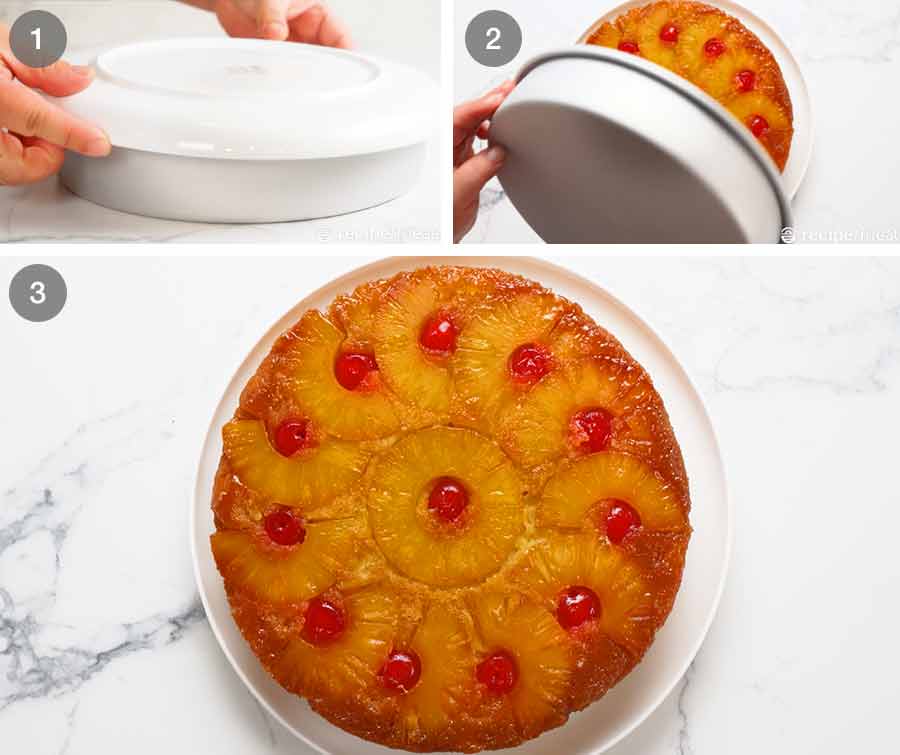
-
Cover cake pan with a plate or serving platter;
-
Flip with confidence – now is not the time to hesitate! 😂
-
Lift the cake pan off slowly and … voila!
PRO TIP: If, when lifting off the inverted cake pan (slowly!), you can tell that the base is sticking, tap the base gently and/or shake gently. This will help loosen it. That said, with the amount of butter used in the base to make the caramel "sauce" that soaks into the pineapple topping, it is highly improbable that you'll encounter sticking issues. But stranger things have happened in life!
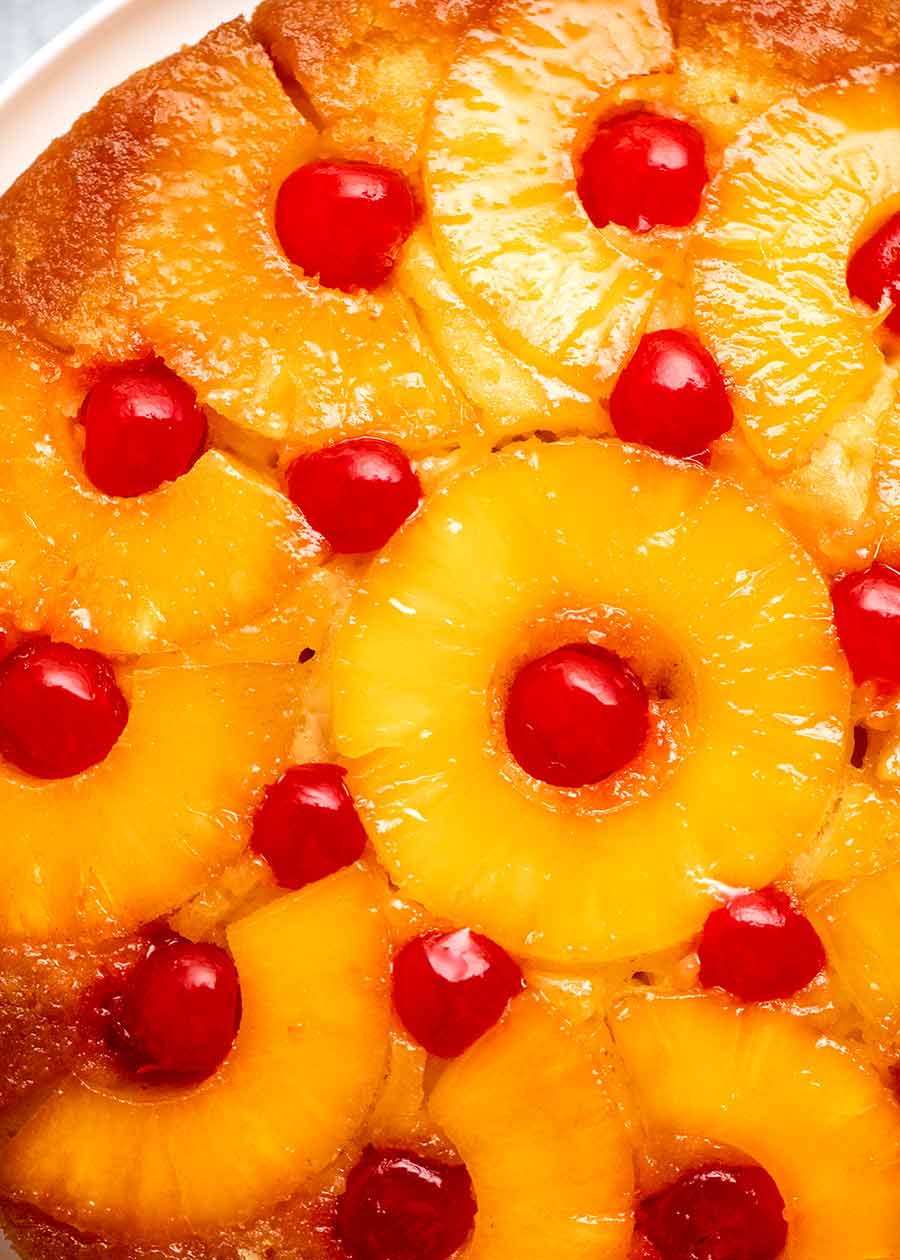
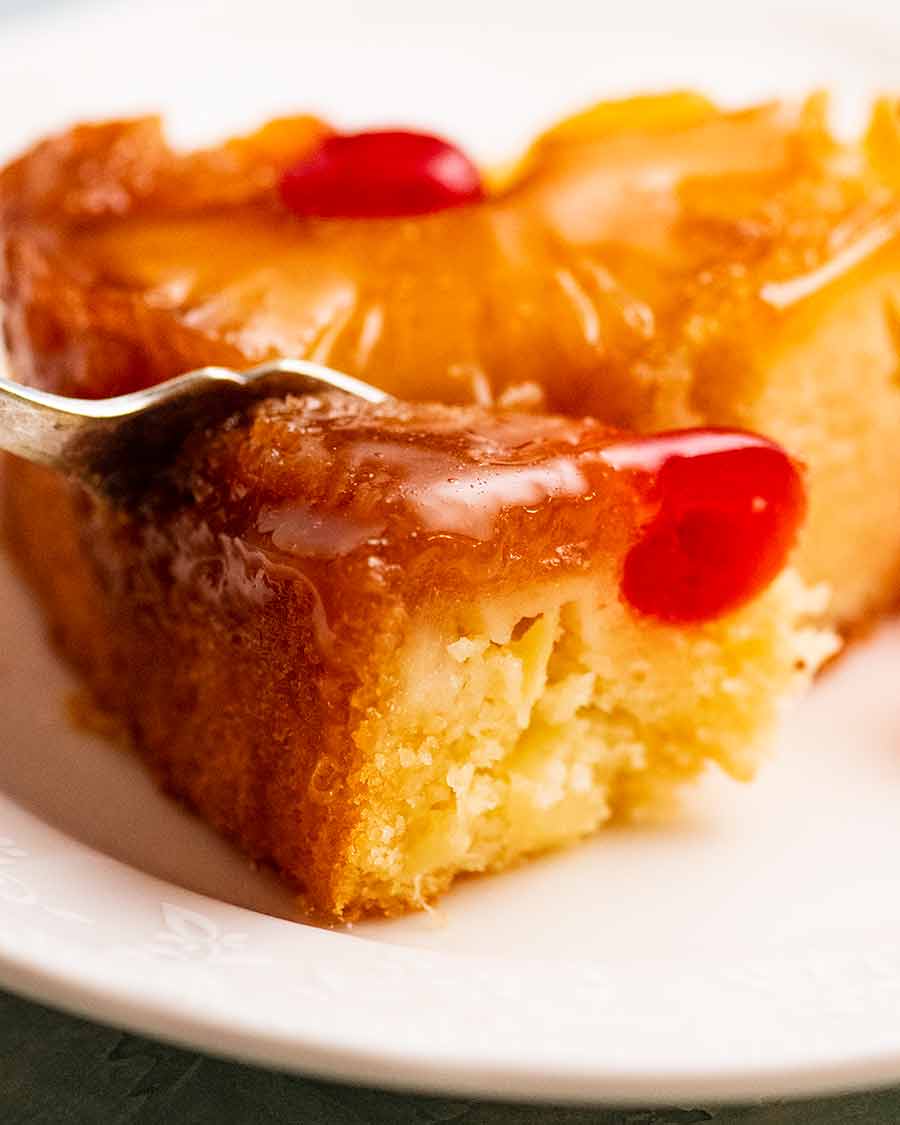
This is not a very tall cake. It stands around 4cm/ 1.6″ tall using a 23cm/9″ cake pan. A smaller cake pan would make it stand taller but it would take too long for the middle of the cake to cook before the caramel on the base becomes too brown, I think.
Also, at this height, you have a nice ratio of cake to caramelised pineapple.
Pineapple Upside Down Cake will keep for 5 days or so in the fridge. The crumb will get a bit more soaked with those caramel pineapple juices as it sits. But nobody complains, that's for sure! – Nagi x
PS. This is what I was listening to as I was typing up this post. Just in case you also want to get into the retro spirit. 👯♂️
Watch how to make it
Subscribe to my newsletter and follow along on Facebook, Pinterest and Instagram for all of the latest updates.
Servings 10 – 12 people
Tap or hover to scale
Recipe video above. Bringing back the retro classic! You will love everything about this cake. The sticky, caramelised pineapple and cherry topping. The ultra-tender and moist vanilla cake. How it's studded with pineapple bits inside. And how we use some of the pineapple juice to flavour the cake. Because why would we waste it??
Topping:
- 565g/ 20 oz canned pineapple slices in juice (not in syrup, Note 1)
- 12 – 18+ maraschino cherries (Note 2)
- 60g/ 4 tbsp unsalted butter , melted
- 1/2 cup brown sugar
CAKE:
- 1 1/2 cups flour
- 1 tsp baking powder
- 1/4 tsp baking soda (sub 1 tsp baking powder)
- 1/4 tsp salt
- 1/3 cup milk , full or low-fat
- 1/4 cup pineapple juice , reserved from can (under Topping ingredients)
- 1/4 cup sour cream , full fat (sub plain yogurt)
- 1 tsp vanilla extract (or essence)
- 115g/ 1 stick butter , unsalted, softened (to 18C/64F, Note 3)
- 3/4 cup white sugar
- 2 large eggs , at room temperature (Note 4)
- Any leftover pineapple , chopped (Note 1)
-
Preheat oven to 180°C/350°F (160°C fan).
Pineapple decorative top:
-
Dry fruits: Line a tray with paper towels or a tea towel, then place pineapple and cherries on. Pat dry with paper towels.
-
Butter: Pour melted butter into a 23cm/9" cake pan at least 5cm/2" deep. (Not springform, as they'll leak.) Brush butter up the sides.
-
Brown sugar: Sprinkle sugar over the base, roughly spreading it out (use the brush).
-
Arrange pineapple: Place one pineapple ring in the centre, then surround with either halved pineapple rings (as pictured), or whole ones.
-
Decorate with cherries as desired. Most people just put them in the middle of the pineapple rings.
-
Press cherries and pineapples down firmly so they are in direct contact with the base of the cake pan – so you get vibrant red and yellow colour pops at the end, not tarnished by caramel. (Note 5)
Batter:
-
Flour Mixture: Whisk flour, baking powder, baking soda and salt in a bowl.
-
Milk Mixture: Whisk milk, sour cream, pineapple juice and vanilla in a 2nd bowl.
-
Cream butter and sugar: In a third (final!) bowl, beat the butter and sugar for 2 minutes on speed 7 (handheld mixer) until fluffy.
-
Eggs: Add eggs one at a time, beating for 20 seconds in between.
-
Add Flour Mixture then Milk Mixture, alternating: Add 1/3 of the Flour Mixture, then mix in using a rubber spatula. Add 1/2 the Milk Mixture, mix in. Add half the remaining Flour Mixture, mix. Add all the remaining Milk Mixture, mix. Then mix in the last of the Flour Mixture. Stir in the leftover pineapple pieces.
-
Fill pan: Spread batter over pineapple layer, smooth and level the surface.
-
Bake: Bake for 30 minutes. Remove, loosely cover with foil, then bake for a further 15 minutes until a toothpick inserted into the centre comes out clean.
Turning out cake:
-
Cool 20 minutes: Remove cake from oven and leave inside pan to cool for 20 minutes.
-
Flip! Run a butter knife around the inner edge of the cake pan. Put a plate or serving platter over the cake, then flip. Tap base / shake pan gently then lift slowly. Voila!
-
Cool completely before serving.
1. Pineapple slices – Be sure to get pineapple in juice, not syrup. Syrup is too sweet and also the cake batter calls for pineapple juice.
Cans: In Australia, the standard can sizes are 430g and 225g, so get one of each. Total 655g, which is more than needed. Chop up the leftover pineapple and add into the batter.
2. Maraschino cherries – Preserved, sweetened cherries commonly associated as a cocktail garnish! Find them at liquor stores or Harris Farms (Sydney/QLD). Glacé cherries also work!
3. Softened butter – Don't let the butter get too soft and sloppy. This is a common error with cakes that call for butter and sugar to be creamed. Target 18C/64F for the butter. At this temperature, the butter is loose enough to be whipped, but you should not be left with a thick, shiny slick of grease on your finger when you poke it. If you get greasy fingers, this means the butter is too soft. The cake will not be as fluffy as intended, or the batter might split and be greasy.
If the butter is >20C/68F, I would chill the butter a bit before using.
4. Eggs – Eggs need to be at room temperature and not fridge-cold, to ensure it incorporates properly into the batter. A quick way to warm up fridge-cold eggs: Place eggs in a large bowl, cover with warm tap water (just warm, not hot) and leave for 5 minutes. Wipe dry (to avoid residual water dripping into bowl), then use per recipe.
Large eggs: 50 – 55g / 2 oz per egg is the industry standard of sizes sold as "large eggs" in Australia and the US. If your eggs are significantly larger or smaller in size, just weigh different eggs and use 200 – 220g / 8 oz in total (including shell) or 180 – 200g / 7.3 oz in total excluding shell (this is useful if you need to use a partial egg to make up the total required weight. Crack eggs, beat whites and yolks together, THEN pour into a bowl to measure out what you need).
5. Pressing the pineapple and cherries down firmly means their presentation side won't be coated as much in brown caramel, letting the colours shine through more visibly.
6. Optional extra glossy shine for presentation purposes: Corn syrup (warmed), or apricot jam (warm, loosen slightly with water). Brush onto the pineapple and cherry surface after turning out cake.
7. Storage – Keeps in the fridge for at least 5 days. Be sure to bring to room temperature before serving. Nobody wants cold cake!
8. Nutrition per slice, assuming 12 slices.
Calories: 319 cal (16%) Carbohydrates: 47 g (16%) Protein: 3 g (6%) Fat: 14 g (22%) Saturated Fat: 8 g (50%) Trans Fat: 1 g Cholesterol: 61 mg (20%) Sodium: 162 mg (7%) Potassium: 160 mg (5%) Fiber: 1 g (4%) Sugar: 34 g (38%) Vitamin A: 468 IU (9%) Vitamin C: 5 mg (6%) Calcium: 60 mg (6%) Iron: 1 mg (6%)
Keywords: Pineapple cake, Pineapple Upside Down Cake
More classic cakes
Life of Dozer
Cake, anyone?

Pineapple Upside Down Cheesecake Recipe
Source: https://www.recipetineats.com/pineapple-upside-down-cake/
Posted by: robinsonfidlen1956.blogspot.com

0 Response to "Pineapple Upside Down Cheesecake Recipe"
Post a Comment